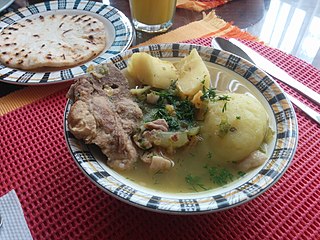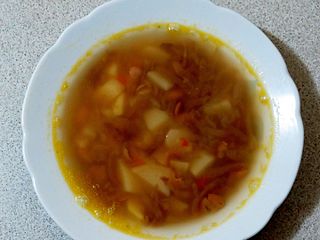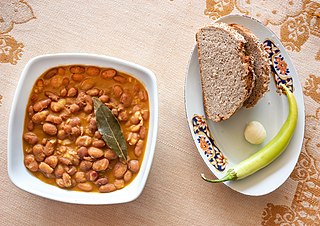Related Research Articles

Feijoada is a stew of beans with beef and pork. The name feijoada is derived from feijão, 'bean' in Portuguese. Varieties are prepared in the Portuguese-speaking world. The basic ingredients of feijoada are beans and fresh pork or beef.

Ghormeh sabzi or Khoresht sabzi, also spelled qormeh sabzi, is an Iranian herb stew. It is considered the national dish and is a very popular dish in Iran. Ghormeh sabzi has different variants, which are based on the difference between beans and meat.

Sancocho is a traditional stew in Canarian cuisine and several Latin American cuisines. Latin variations represent popular national dishes in Dominican Republic, Colombia, Cuba, Honduras, Mexico, Ecuador, Panama, Puerto Rico, Trinidad and Tobago, and Venezuela. It usually consists of large pieces of meat, tubers and vegetables served in a broth.

Tomato bredie is a South African stew, referred to in Afrikaans as 'tamatiebredie', normally made with mutton. It is cooked for a very long time, and its seasonings include cinnamon, cardamom, ginger and cloves as well as chilli. "Bredie" is the Afrikaans word for "stew", but is actually a word of Malaysian origin. This form of cooking was introduced to the Cape by Malays, who were brought to the colony in most cases as slaves. The word bredie refers to oriental spinach. In tomato bredie tomato is used instead. Pumpkin, green beans and waterblommetjies are also used. This traditional South African dish is commonly eaten around South Africa by both locals and tourists.

Caparrones is a Spanish stew made of caparrón, a variety of red kidney bean, and a spicy sausage chorizo, both of which are local specialties of the Spanish La Rioja region. The shape of caparrón bean is shorter and rounder than common red kidney beans. The stew is regarded as one of the most important dishes in Riojan cooking.

The jota or Istrian stew is a soup made with beans and sauerkraut or sour turnip, potatoes, bacon, and spare ribs, known in the northern Adriatic regions. Under the name jota, it is typical and especially popular in Trieste and its province, in the Istrian peninsula, in the province of Gorizia, in the whole Slovenian Littoral, in the Rijeka area, and in Friuli, especially in some of its peripheral areas. The stew, based on etymology, most likely originated in Friuli before spreading east and south.

Dominican cuisine is made up of Spanish, indigenous Taíno, Middle Eastern, and African influences. The most recent influences in Dominican cuisine are from the British West Indies and China.
Sagamité is a Native American stew made from hominy, cornmeal, or Indian corn and grease. Additional ingredients may include vegetables, wild rice, brown sugar, beans, smoked fish or animal brains.

Khoresh or Khoresht is a generic Iranian term for stew dishes in the Iranian cuisine, Afghan cuisine, Tajik cuisine and also Kurdish cuisine. The word is a substantive of the verb khordan "to eat" and literally means "meal".
Advieh means spice in the Persian language and it is a spice mixture used in Iranian cuisine. It is used in rice dishes, as well as in chicken and bean dishes. Although its specific composition varies from the Persian Gulf to the Caspian Sea, common ingredients include turmeric, cinnamon, cardamom, cloves, rose petals or rose buds, cumin, and ginger. It may also include ground golpar, saffron, nutmeg, black pepper, mace, coriander, or sesame.

Pasulj, grah (грах) or grav (грав) is a bean stew made of usually white, cranberry or pinto beans, and more rarely kidney beans that is a popular dish in Balkan cuisine. It is normally prepared with meat, particularly smoked meat such as smoked bacon, sausage, and ham hock, and is a typical winter dish. Other commonly used ingredients include carrots and onions. Another version of the dish using baked beans is known as prebranac (пребранац).

Cocido montañés is a rich hearty Spanish bean stew, originally from and most commonly found in Cantabria in northern Spain.

Kapuska is a hearty traditional Turkish cuisine and Balkan cuisine stew whose name is derived from the Slavic languages word for cabbage. Although the name is imported, the dish is a Turkish version of a cabbage stew common in Russia, Ukraine, Poland and other countries of Eastern Europe. Kapuska is widely known and consumed in the Thrace and Black Sea regions of Turkey.

Pastelón is a Dominican and Puerto Rican dish. The dish is prepared differently on both islands.

Kuru fasulye is a stewed bean dish in Turkish cuisine. It is made primarily with white beans and olive oil, and onion and tomato paste or tomato sauce are almost invariably used. Sometimes other vegetables or meat may also be added, especially pastirma. Kuru fasulye is often served along with cacık and rice or bulgur. It is often considered the national dish of Turkey.

A stew is a combination of solid food ingredients that have been cooked in liquid and served in the resultant gravy. Ingredients can include any combination of vegetables and may include meat, especially tougher meats suitable for slow-cooking, such as beef, pork, venison, rabbit, lamb, poultry, sausages, and seafood. While water can be used as the stew-cooking liquid, stock is also common. A small amount of red wine or other alcohol is sometimes added for flavour. Seasonings and flavourings may also be added. Stews are typically cooked at a relatively low temperature, allowing flavours to mingle.
Capra e fagioli or stufato di capra e fagioli is a typical dish of the hinterland of Imperia.
Linat-an, also known as nilat-an, is a traditional pork stew from the Visayas and Mindanao islands of the Philippines. Linat-an characteristically uses pork ribs boiled and simmered until very tender, lemongrass, string beans, and starchy ingredients for a thicker soup. Like the very similar nilagang baboy, the rest of its ingredients can vary, but they typically include chayote, water spinach, onion, garlic, pechay, calabaza, and bell peppers. It is seasoned with salt, ground black pepper, and fish sauce to taste.
References
- ↑ "Recipe: Vegan Dominican Chapea Stew". MLive.com. November 6, 2013. Retrieved December 22, 2017.